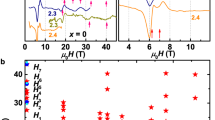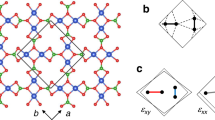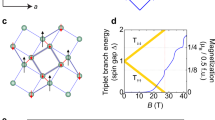Abstract
The study of interacting spin systems is of fundamental importance for modern condensed-matter physics. On frustrated lattices, magnetic exchange interactions cannot be simultaneously satisfied, and often give rise to competing exotic ground states1. The frustrated two-dimensional Shastry–Sutherland lattice2 realized by SrCu2(BO3)2 (refs 3,4) is an important test case for our understanding of quantum magnetism. It was constructed to have an exactly solvable 2-spin dimer singlet ground state within a certain range of exchange parameters and frustration. While the exact dimer state and the antiferromagnetic order at both ends of the phase diagram are well known, the ground state and spin correlations in the intermediate frustration range have been widely debated2,4,5,6,7,8,9,10,11,12,13,14. We report here the first experimental identification of the conjectured plaquette singlet intermediate phase in SrCu2(BO3)2. It is observed by inelastic neutron scattering after pressure tuning to 21.5 kbar. This gapped singlet state leads to a transition to long-range antiferromagnetic order above 40 kbar, consistent with the existence of a deconfined quantum critical point.
This is a preview of subscription content, access via your institution
Access options
Access Nature and 54 other Nature Portfolio journals
Get Nature+, our best-value online-access subscription
$32.99 / 30 days
cancel any time
Subscribe to this journal
Receive 12 print issues and online access
$259.00 per year
only $21.58 per issue
Buy this article
- Purchase on SpringerLink
- Instant access to full article PDF
Prices may be subject to local taxes which are calculated during checkout




Similar content being viewed by others
References
Lhuillier, C. & Misguich, G. in High Magnetic Fields (eds Berthier, C., Lvy, L. & Martinez, G.) 161–190 (Lecture Notes in Physics, 595, Springer, 2001).
Shastry, B. S. & Sutherland, B. Exact ground state of a quantum mechanical antiferromagnet. Physica B+C 108, 1069–1070 (1981).
Kageyama, H. et al. Exact dimer ground state and quantized magnetization plateaus in the two-dimensional spin system SrCu2(BO3)2 . Phys. Rev. Lett. 82, 3168–3171 (1999).
Miyahara, S. & Ueda, K. Theory of the orthogonal dimer Heisenberg spin model for SrCu2(BO3)2 . J. Phys. Condens. Matter 15, R327 (2003).
Albrecht, M. & Mila, F. First-order transition between magnetic order and valence bond order in a 2D frustrated Heisenberg model. Europhys. Lett. 34, 145–150 (1996).
Weihong, Z., Hamer, C. J. & Oitmaa, J. Series expansions for a Heisenberg antiferromagnetic model for SrCu2(BO3)2 . Phys. Rev. B 60, 6608–6616 (1999).
Müller-Hartmann, E., Singh, R. R. P., Knetter, C. & Uhrig, G. S. Exact demonstration of magnetization plateaus and first-order Dimer-Néel phase transitions in a modified Shastry–Sutherland model for SrCu2(BO3)2 . Phys. Rev. Lett. 84, 1808–1811 (2000).
Knetter, C., Bühler, A., Müller-Hartmann, E. & Uhrig, G. S. Dispersion and symmetry of bound states in the Shastry–Sutherland model. Phys. Rev. Lett. 85, 3958–3961 (2000).
Koga, A. & Kawakami, N. Quantum phase transitions in the Shastry–Sutherland model for SrCu2(BO3)2 . Phys. Rev. Lett. 84, 4461–4464 (2000).
Takushima, Y., Koga, A. & Kawakami, N. Competing spin-gap phases in a frustrated quantum spin system in two dimensions. J. Phys. Soc. Jpn 70, 1369–1374 (2001).
Zheng, W., Oitmaa, J. & Hamer, C. J. Phase diagram of the Shastry–Sutherland antiferromagnet. Phys. Rev. B 65, 014408 (2001).
Läuchli, A., Wessel, S. & Sigrist, M. Phase diagram of the quadrumerized Shastry–Sutherland model. Phys. Rev. B 66, 014401 (2002).
Al Hajj, M. & Malrieu, J.-P. Phase transitions in the Shastry–Sutherland lattice. Phys. Rev. B 72, 094436 (2005).
Ronquillo, D. C. & Peterson, M. R. Identifying topological order in the Shastry–Sutherland model via entanglement entropy. Phys. Rev. B 90, 201108(R) (2014).
Majumdar, C. K. & Ghosh, D. K. On next nearest neighbor interaction in linear chain. I. J. Math. Phys. 10, 1388–1398 (1969).
Dalla Piazza, B. et al. Fractional excitations in the square-lattice quantum antiferromagnet. Nat. Phys. 11, 62–68 (2015).
Momoi, T. & Totsuka, K. Magnetization plateaus of the Shastry–Sutherland model for SrCu2(BO3)2: spin-density wave, supersolid, and bound states. Phys. Rev. B 62, 15067–15078 (2000).
Dorier, J., Schmidt, K. P. & Mila, F. Theory of magnetization plateaux in the Shastry–Sutherland model. Phys. Rev. Lett. 101, 250402 (2008).
Matsuda, Y. H. et al. Magnetization of SrCu2(BO3)2 in Ultrahigh Magnetic Fields up to 118 T. Phys. Rev. Lett. 111, 137204 (2013).
Corboz, P. & Mila, F. Tensor network study of the Shastry–Sutherland model in zero magnetic field. Phys. Rev. B 87, 115144 (2013).
Senthil, T., Vishwanath, A., Balents, L., Sachdev, S. & Fisher, M. P. A. Deconfined quantum critical points. Science 303, 1490–1494 (2004).
Merchant, P. et al. Quantum and classical criticality in a dimerized quantum antiferromagnet. Nat. Phys. 10, 373–379 (2014).
Kageyama, H., Mushnikov, N. V., Yamada, M., Goto, T. & Ueda, Y. Quantum phase transitions in the orthogonal dimer system SrCu2(BO3)2 . Physica B 329–333, 1020–1023 (2003).
Sakurai, T. et al. High-field and high-pressure ESR measurements of SrCu2(BO3)2 . J. Phys. Conf. Ser. 150, 042171 (2009).
Waki, T. et al. A novel ordered phase in SrCu2(BO3)2 under high pressure. J. Phys. Soc. Jpn. 76, 073710 (2007).
Haravifard, S. et al. Continuous and discontinuous quantum phase transitions in a model two-dimensional magnet. Proc. Natl Acad. Sci. USA 109, 2286–2289 (2012).
Loa, I. et al. Crystal structure and lattice dynamics of at high pressures. Physica B 359–361, 980–982 (2005).
Zayed, M. E. et al. Temperature dependence of the pressure induced monoclinic distortion in the spin Shastry–Sutherland compound SrCu2(BO3)2 . Solid State Commun. 186, 13–17 (2014).
Haravifard, S. et al. Emergence of long-range order in sheets of magnetic dimers. Proc. Natl Acad. Sci. USA 111, 14372–14377 (2014).
Zayed, M. Novel States in Magnetic Materials under Extreme Conditions. A High Pressure Neutron Scattering Study of the Shastry–Sutherland Compound SrCu 2 (BO 3)2 PhD thesis, ETH Zurich (2010).
Ruegg, C. et al. Bose-Einstein condensation of the triplet states in the magnetic insulator TlCuCl3 . Nature 423, 62–65 (2003).
Haravifard, S. et al. Crystallization of spin superlattices with pressure and field in the layered magnet SrCu2(BO3)2 . Nat. Commun. 7, 11956 (2016).
Schneidewind, A. & Čermàk, P. PANDA: Cold three axes spectrometer. J. Large-Scale Res. Facil. 1, A12 (2015).
Klotz, S. Techniques in High Pressure Neutron Scattering (CRC Press, Taylor and Francis, 2013).
Zayed, M. E. et al. Correlated decay of triplet excitations in the Shastry–Sutherland compound SrCu2(BO3)2 . Phys. Rev. Lett. 113, 067201 (2014).
Klotz, S. Phonon dispersion curves by inelastic neutron scattering to 12 GPa. Z. Kristallogr. 216, 420–429 (2001).
Kakurai, K. et al. Neutron scattering investigation on quantum spin system SrCu2(BO3)2 . Prog. Theor. Phys. Suppl. 159, 22–32 (2005).
Koga, A., Okunishi, K. & Kawakami, N. First-order quantum phase transition in the orthogonal-dimer spin chain. Phys. Rev. B 62, 5558–5563 (2000).
Acknowledgements
We thank A. Magee for her contributions to the susceptibility measurements, M. Merlini and M. Hanfland for support during high-pressure X-ray diffraction experiments at the ESRF, and M. Ay and P. Link for assistance during neutron scattering experiments. We acknowledge F. Mila and B. Normand for many useful discussions. We also thank CamCool Research Ltd for supplying the pressure cells for the SQUID measurements. This work is based on experiments performed at the Swiss spallation neutron source SINQ, Paul Scherrer Institute, Villigen, Switzerland, at the FRM-2, Munich, Germany, and at the ILL, Grenoble, France. We thank the Swiss National Science Foundation SNF and the Royal Society (UK) for financial support. The work in London and Cambridge was supported by the EPSRC. J.L.J. acknowledges the Science Without Borders program of CNPq/MCTI-Brazil and C.P. acknowledges financial support from the National Research Foundation (NRF) of Singapore, through NRF Investigatorship (Reference No. NRF-NRFI2015-04).
Author information
Authors and Affiliations
Contributions
M.E.Z., C.R. and H.M.R. designed the research, performed the experiments and analysed the data. A.M.L. computed the magnetic susceptibility by exact diagonalization. C.P., S.S.S. and M.E. helped with susceptibility experiments. T.S., S.K., G.H. and R.A.S. provided neutron high-pressure techniques. M.B., M.J.-R., A.S., V.P. and T.S. provided support for neutron experiments. E.P., M.S. and K.C. synthesized the SrCu2(BO3)2 samples. J.L.J. and D.F.M. contributed to interpretation of the data. M.E.Z., C.R. and H.M.R. wrote the manuscript with contributions from all co-authors.
Corresponding author
Ethics declarations
Competing interests
The authors declare no competing financial interests.
Supplementary information
Supplementary information
Supplementary information (PDF 454 kb)
Rights and permissions
About this article
Cite this article
Zayed, M., Rüegg, C., Larrea J., J. et al. 4-spin plaquette singlet state in the Shastry–Sutherland compound SrCu2(BO3)2. Nature Phys 13, 962–966 (2017). https://doi.org/10.1038/nphys4190
Received:
Accepted:
Published:
Issue date:
DOI: https://doi.org/10.1038/nphys4190
This article is cited by
-
Deconfined quantum critical point lost in pressurized SrCu2(BO3)2
Communications Physics (2025)
-
Development of ESR Measurement Systems for Higher Magnetic Fields and Pressures
Applied Magnetic Resonance (2025)
-
Field-induced bound-state condensation and spin-nematic phase in SrCu2(BO3)2 revealed by neutron scattering up to 25.9 T
Nature Communications (2024)
-
Hidden orders and phase transitions for the fully packed quantum loop model on the triangular lattice
Communications Physics (2024)
-
Field-controlled multicritical behavior and emergent universality in fully frustrated quantum magnets
npj Quantum Materials (2024)



